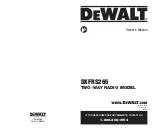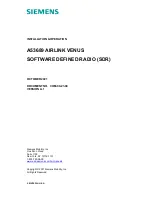
A-5
A-6
ENGLISH
•
Limit the amount of time you use headsets or earpiece at high volume
levels.
•
When using the radio without a headset or earpiece, do not place the
radio’s speaker directly against your ear.
2. Observe all signs and instructions that require an electrical device or RF
radio product to be switched off in designated areas, such as gas/refueling
stations, hospitals, blasting areas, potentially explosive atmospheres, or
aircraft.
3. If you experience a skin irritation after using this product, discontinue use
and seek medical attention.
4. If the product or charger: overheats; has a damaged cord or plug; has been
dropped or damaged; has been dropped into water, disconnect any charger
from its power supply, discontinue use of the product.
5. Never use your radio outdoors during a thunderstorm. Keep the radio out of
reach of babies and young children.
6.
NEVER
hold the radio so that the antenna is very close to, or touching
exposed parts of the body, especially the face or eyes, while transmitting.
The radio will perform best if the microphone is around 2 inches (5 cm)
away from the lips and the radio is vertical.
Electromagnetic Interference
Nearly every electronic device is susceptible to electromagnetic interference
(EMI) if inadequately shielded, designed, or otherwise configured for
electromagnetic compatibility. Turn off your radio in any facility where posted
notices instruct you to do so. These facilities may include hospitals or health
care facilities that may be using equipment that is sensitive to external RF
energy.
• When instructed to do so, turn off your radios when on board an aircraft. Any
use of a RF device must be in accordance with applicable laws, regulations
and airline crew instructions.
• Some radios may interfere with some hearing aids. In the event of such
interference, you may want to consult your hearing aid manufacturer or
physician to discuss alternatives.
• If you use any other personal medical device, consult the manufacturer of
your device to determine if it is adequately shielded from RF energy. Your
doctor or physician may be able to assist you in obtaining this information.
Important
CAUTION
:
NEVER
short the terminals of the battery pack.
DO NOT
push the
PTT
button when not actually desiring to transmit.
DO NOT
modify the transceiver for any reason.
AVOID
using or placing the transceiver in direct sunlight or in areas with temperatures
exceed –20° C ~ +50° C / –5° F ~ +120° F.
KEEP
the transceiver from the heavy rain, and NEVER immerse it in water.
The use of battery packs/chargers not included in this package may impair
transceiver performance and invalidate the warranty.
Changes or modifications not expressly approved by DEWALT, may void the user’s authority
granted by the FCC/IC to operate this radio and should not be made. To comply with FCC/IC
requirements, transmitter adjustments should be made only by or under the supervision of a
person certified as technically qualified to perform transmitter maintenance and repairs in
the private Land Mobile and Fixed Services as certified by an organization representative of
the user of those services.
Replacement of any transmitter component (crystal, semiconductor, etc.) not authorized by
the FCC/IC equipment authorization for this radio could violate FCC/IC rules.
Use of this radio outside the country where it was intended to be distributed is subject to
government regulations and may be prohibited.
IMPORTANT NOTICE:
WARNING
:
Changes or modifications to this unit not expressly approved by the party
responsible for compliance could void the user’s authority to operate the equipment.
This device complies with Part 15 of the FCC Rules. Operation is subject to the following two
conditions: 1) This device may not cause harmful interference, and 2) this device must accept
any interference received,including interference that may cause undesired operation.
NOTE:
This equipment has been tested and found to comply with the limits for a Class B digital
device, pursuant to Part 15 of the FCC Rules. These limits are designed to provide reasonable
protection against harmful interference in a residential installation. This equipment generates,
uses and can radiate radio frequency energy and, if not installed and used in accordance with
the instructions, may cause harmful interference to radio communications.
However, there is no guarantee that interference will not occur in a particular installation. If this
equipment does cause harmful interference to radio or television reception, which can be
determined by turning the equipment off and on, the user is encouraged to try to correct the
interference by one or more of the following measures:
• Reorient or relocate the receiving antenna.
• Increase the separation between the equipment and receiver.
• Connect the equipment into an outlet on a circuit different from that to which the receiver is
connected.
• Consult the dealer or an experienced radio/TV technician for help.
Safety Information for Radios
Your wireless handheld portable transceiver contains a low power transmitter. When the talk
button is pushed, it sends out radio frequency (RF) signals. The device is authorized to operate at
a duty factor not to exceed 50%. In August 1996, the Federal Communications Commissions
(FCC) adopted RF exposure guidelines with safety levels for handheld wireless devices
Important
FCC RF Exposure Requirements: For body-worn operation, this radio has been tested and meets
the FCC RF exposure guidelines when used with DEWALT accessories supplied or designated for
this product. Use of other accessories may not ensure compliance with FCC RF exposure
guidelines. Use only the supplied antenna. Unauthorized antennas, modifications or attachments
could damage the transmitter and may violate FCC regulations.
Normal Position
Hold the transmitter approximately 2 inches from your face and speak in a normal voice, with the
antenna pointed up and away.
FCC Part 15.21 Warning Statement-
NOTE:
THE GRANTEE IS NOT RESPONSIBLE FOR ANY CHANGES OR MODIFICATIONS NOT
EXPRESSLY APPROVED BY THE PARTY RESPONSIBLE FOR COMPLIANCE. SUCH MODIFICATIONS
COULD VOID THE USER’S AUTHORITY TO OPERATE THE EQUIPMENT.
ISEDC RSS Warning
This product meets the applicable Industry Canada technical specifications. / Le présent matériel
est conforme aux specifications techniques applicables d’Industrie Canada.
This device complies with ISEDC license-exempt RSS standard (s). Operation is subject to the
following two conditions: (1) this device may not cause interference, and (2) this device must
accept any interference, including interference that may cause undesired operation of the device.
Le présent appareil est conforme aux CNR d'ISEDC applicables aux appareils radio exempts de
licence. L'exploitation est autorisée aux deux conditions suivantes:
(1) l'appareil ne doit pas produire de brouillage, et
(2) l'utilisateur de l'appareil doit accepter tout brouillage radioélectrique subi, même si le
brouillage est susceptible d'en compromettre le fonctionnement.
ISEDC Radiation Exposure Statement:
For body worn operation, this model device has been tested and meets the FCC/ISED RF
exposure guidelines when used with an accessory designated for this product or when used with
an accessory that Contains no metal and that positions of the face up minimum distance is
25mm.
Any Changes or modifications not expressly approved by the party responsible for compliance
could void the user’s authority to operate the equipment.
Pour le corps, ce modèle d’appareil a été testé et adapté à la RF renforcée Lignes directrices
relatives à l’exposition lorsqu’elles sont utilisées avec un accessoire pour ce produit ou
lorsqu’elles sont utilisées avec celui-ci. Un acces-soire ne contenant pas de métal et dont la
distance minimale de la face est de 25 mm
Tout changement ou modification non expressément approuvé par la partie responsable de la
conformité l'équipement.
Your wireless handheld portable transceiver contains a low power transmitter. When the talk
button is pushed, it sends out radio frequency (RF) signals. The device is authorized to operate at
a duty factor not to exceed 50%.
Votre émetteur-récepteur portable sans fil contient un émetteur de faible puissance. Lorsque le
bouton de conversation est enfoncé, il envoie des signaux de radiofréquence (RF). L'appareil est
autorisé à fonctionner avec un facteur d'utilisation ne dépassant pas 50%.






























